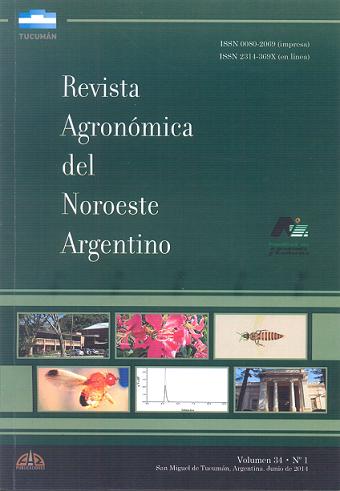Ver ítem
- xmlui.general.dspace_homeCentros Regionales y EEAsCentro Regional Buenos Aires NorteEEA PergaminoArtículos científicosxmlui.ArtifactBrowser.ItemViewer.trail
- Inicio
- Centros Regionales y EEAs
- Centro Regional Buenos Aires Norte
- EEA Pergamino
- Artículos científicos
- Ver ítem
Importancia, toxicogénesis y agresividad de especies pertenecientes a Gibberella fujikuroi en maíz en el Noroeste Argentino = Importance, Fumonisin production and aggressiveness of Gibberella fujikuroi complex recovered from maize in northwestern Argentina
Resumen
Se estudió la composición, patogenicidad y toxicogénesis de aislamientos pertenecientes al complejo Gibberella fujikuroi en una de las regiones productoras de maíz de la región Noroeste de Argentina. Los resultados evidencian que el género Fusarium Sección Liseola está conformado por tres especies. La especie dominante fue la población tipo A (F. verticillioides), representada por un 53% seguida de la población tipo D (F. proliferatum) representando un 29
[ver mas...]
Se estudió la composición, patogenicidad y toxicogénesis de aislamientos pertenecientes al complejo Gibberella fujikuroi en una de las regiones productoras de maíz de la región Noroeste de Argentina. Los resultados evidencian que el género Fusarium Sección Liseola está conformado por tres especies. La especie dominante fue la población tipo A (F. verticillioides), representada por un 53% seguida de la población tipo D (F. proliferatum) representando un 29 %. Y por último la población E (F. subglutinans) en un 18 %. Se detectó variabilidad entre aislamientos respecto a su agresividad hacia tres híbridos de maíz, con niveles de resistencia variable, sin que se haya observado un importante efecto de interacción híbrido× aislamiento. La producción de fumonisinas en los aislamientos de F. verticillioides varió de 4000 a 7457 ppb. Los correspondiente a la población de apareamiento tipo E (F. subglutinans) produjeron muy bajos niveles de fumonisinas variando de 0,1 a 0,54 a mg/kg (ppb). La información lograda en el presente trabajo representa un primer paso, para la región en estudio, hacia el conocimiento del patosistema Fusarium-maíz, a fin de determinar la importancia de esta enfermedad, y plantear las bases que conduzcan a delinear estrategias de manejo, dentro del marco de una agricultura sustentable.
[Cerrar]
Mating population, in vitro fumonisin production and aggressiveness of maize isolates belonging to the Gibberella fujikuroi complex were assessed in corn producing area of northwestern Argentina. Mating population A (F. verticillioides) was the most prevalent species (53%) coexisting with some
isolates belonging to MAT-D (F. proliferatum) 29% and MAT-E (F. subglutinans) 18%. Fumonisin
production varied from 4000 to 7457 ųg/kg (ppb) for MAT-A and from
[ver mas...]
Mating population, in vitro fumonisin production and aggressiveness of maize isolates belonging to the Gibberella fujikuroi complex were assessed in corn producing area of northwestern Argentina. Mating population A (F. verticillioides) was the most prevalent species (53%) coexisting with some
isolates belonging to MAT-D (F. proliferatum) 29% and MAT-E (F. subglutinans) 18%. Fumonisin
production varied from 4000 to 7457 ųg/kg (ppb) for MAT-A and from 0,1 - 0,54 a ųg/kg for MATE. The isolates belonging to MAT-D produced undetectable levels. All isolates caused more disease
severity to the most susceptible hybrid in comparison to that of the two moderately resistant hybrids regardless of the fungal species, in most environments, but with no effect for the interaction hybrid x isolate. Results indicate that these three Fusarium spp. coexist in the region, with low environmental specialization to cause ear rots, with potential to contaminate the grain with fumonisins and that, broad resistance mechanisms effective across prevalent local fungal species might exist. The information obtained in the present work represents a first step for the region under study and it will help to determine the importance of this disease, and to delineate management strategies within the framework of
sustainable agriculture.
[Cerrar]

Autor
Díaz, C.G.;
Heredia, A.M.;
Iglesias, Juliana;
Presello, Daniel Alberto;
Lori, Gladys Albina;
Fuente
Revista agronómica del noroeste argentino 33 (2) : 25-33 (dic. 2013)
Fecha
2013-12
Editorial
Facultad de Agronomía y Zootecnia, Universidad Nacional de Tucumán
ISSN
0080-2069
2314-369X
2314-369X
Formato
pdf
Tipo de documento
artículo
Palabras Claves
Derechos de acceso
Abierto
 Excepto donde se diga explicitamente, este item se publica bajo la siguiente descripción: Creative Commons Attribution-NonCommercial-ShareAlike 2.5 Unported (CC BY-NC-SA 2.5)
Excepto donde se diga explicitamente, este item se publica bajo la siguiente descripción: Creative Commons Attribution-NonCommercial-ShareAlike 2.5 Unported (CC BY-NC-SA 2.5)


